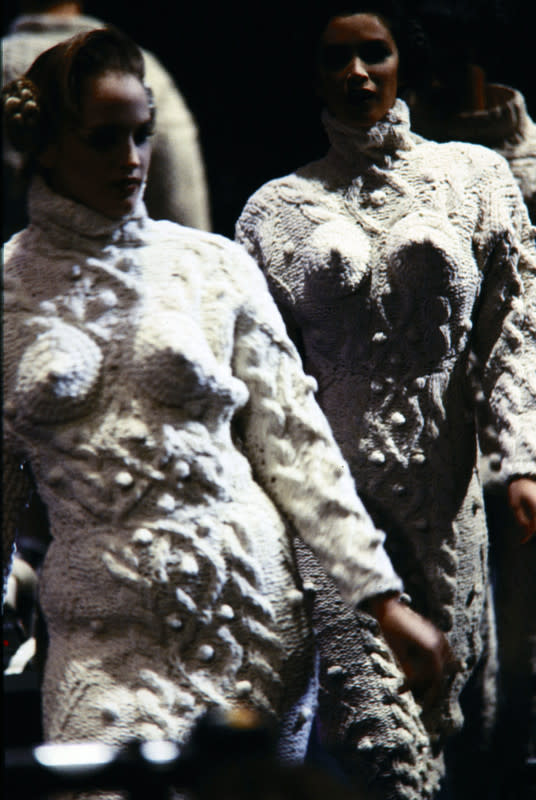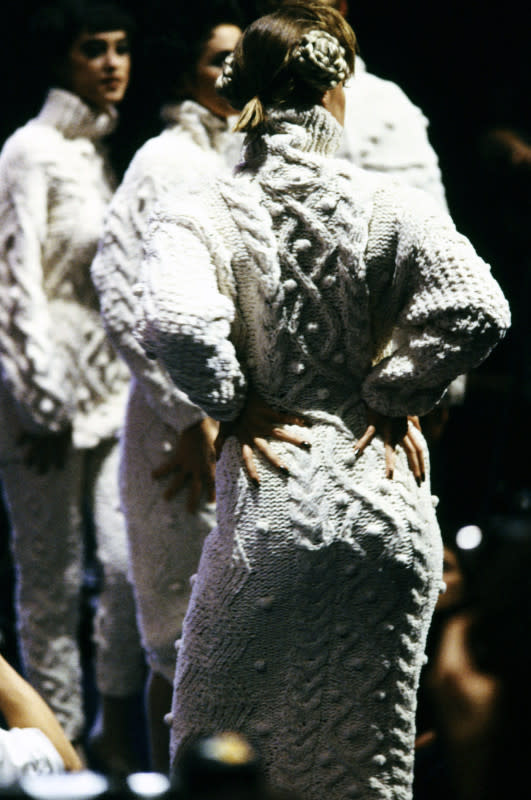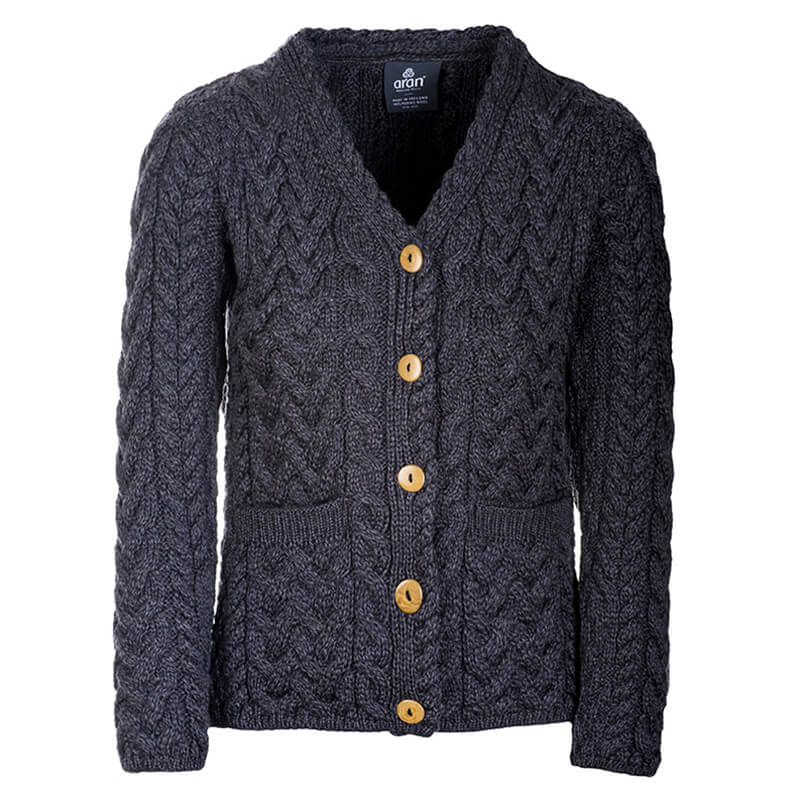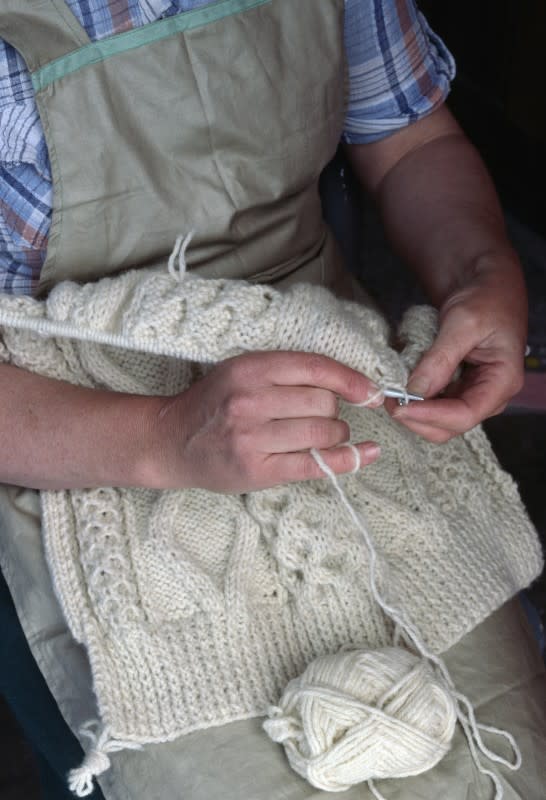Fashion History Lesson: Fisherman Sweaters
Welcome to Fashion History Lesson, in which we dive deep into the origin and evolution of the fashion industry's most influential and omnipresent businesses, icons, trends and more.
What helps an item of clothing reach icon status? Oftentimes, it's the result of lore, whether it's fact or myth — and the Aran jumper, more commonly known as a fisherman sweater, has a lot of it.
Ireland has made a sizable impact on fashion, from contemporary designers like Simone Rocha to historic ones like Sybil Connolly. The Aran jumper is one of its proudest exports, though, claiming an important spot in knitwear's lineage. Its story begins in the late 1800s and extends into modern-day, reimagined by the likes of Jean Paul Gaultier and JW Anderson, embraced by celebrities ranging from Marilyn Monroe to Taylor Swift. It's a staple to many, but it also represents larger resource and manufacturing trends felt in Ireland and beyond.
Keep reading to learn about how the fisherman sweater grew in popularity beyond the Irish shores.
Origins of the Aran Sweater
The sweater gets its names from the Aran Islands, a three-isle cluster on Ireland's west coast, and its roots can be traced back to late 19th century workwear. As its moniker suggests, it was a wardrobe staple for local fishermen, its woolen material ideal for the conditions of that line of work.
"Wives would knit for their husbands and their sons. Originally, they were using raw, unwashed wool, [which] retained the lanolin from the animals — that's what made it waterproof," Lisa Donofrio, assistant chair of fashion design at FIT, tells Fashionista.
The the region had a longstanding tradition of knitting (much like Scotland's gansey sweaters), but it was creativity of the designs that set Aran sweaters apart. It wasn't until the 1940s that the item grew in popularity thanks to commercialization. Muriel Gahan was one of the driving forces behind this, according to Clodagh Doyle, the keeper of the National Museum of Ireland's Irish Folklife Collection: She opened a shop in Dublin in 1930 that sold cottage industry products, including Aran sweaters supplied by knitters who used their craft to generate income for their families.
In an article detailing the sweater's history, Dr. Siún Carden (a research fellow at the University of the Highlands and Islands) wrote that "commercial production began in the late 1930s, with several Irish companies supplying knitters with materials and selling the finished product." The National Museum of Ireland's earliest Aran sweater is from 1937.
The sweater's growing popularity coincided with Ireland seceding from the British Commonwealth and becoming its own country. As Dr. Carden argued in her paper: "Romantic nationalism was fashionable across northern Europe at this time, and Irish eagerness to link Ireland's pre-conquest past with its untested present chimed with international enthusiasm for this kind of historical imagining."
Looks from Jean Paul Gaultier's Fall 1985 collection.

Photo: Guy Marineau/Getty Images

Photo: Guy Marineau/Getty Images
By mid-century, celebrities like Monroe and Grace Kelly were wearing the style in their personal lives and on the silver screen, which helped further boost it as a hot fashion item. "It's The Clancy Brothers wearing the Aran jumper that makes it almost like a worldwide phenomenon, when they played at Carnegie Hall [in 1962]," Doyle says. "They had all been knitted by Mrs. Clancy for her three sons and Davey Arthur." (They wore the style for performances and album covers, including "In Person at Carnegie Hall.")
Fisherman sweaters were featured in magazines like Vogue Knitting, their now-famous moniker entering international vocabulary. Padraig Ó Síocháin's Galway Bay Products company was a main exporter of the knits in the 1950s, credited for growing their global appeal, particularly in Europe, the U.S., Canada and Japan.
The style eventually trickled up into high fashion, appearing on the runways of Jean Paul Gaultier in 1985 and Chanel circa 1999. The Museum of Modern Art in New York City named it one of the most important fashion items of the century in 2017.

The Standard Design
What initially made the Aran sweater interesting was its intricacy, Doyle argues: "They're not following a pattern, and the back is different to the front."
However, this non-standard design became a problem as demand grew. "I think Gahan tried to establish [consistency], but it really isn't until other companies like Galway Bay that really did this in the international market later on," she says.
The Aran sweater is still known for being more decorative than its knit counterparts, especially because of its stitch patterns, which range from cable (interlocked vertical columns) to moss (a woven with slight baubles), trinity (clusters that mimic raspberries and have religious significance), honeycomb (mimics the hexagonal character of the beehive) and more. Oftentimes, a centered column is surrounded by these designs on each side.
These jumpers are traditionally made of wool in crewneck or cardigan silhouettes. While the yarns used to be sourced from Ireland, there was a switch to New Zealand and Australian wool in the '60s and '70s, according to Rosy Temple, the CEO of clothing and retail at Donegal-based brand Magee 1866. This was boosted, in part, by a consumer preference shift towards softness.
"The climate's better [there], so the wool just is a bit softer," Temple says. "Because it's damp and wet here, the wool is slightly harder. The microns — the metric of how soft or hard it is — for New Zealand and Australian yarns can be 22 or 23; Irish wool can be about 29 to 36."
Many Aran-style knits are now made with outsourced wool blends or even fully synthetic materials, which is as much a sustainability issue as an economic one. The switch to non-Irish materials over the last several decades is part of what has thrown the country's wool industry off kilter: The price for the fiber is so low, it can cost farmers more to shear their sheep compared to the value of the fleece. Advocacy groups like the Irish Grown Wool Council — a collective of farmers, academics and business leaders aiming to preserve the country's legacy in wool crafts and textiles — have emerged to combat this.
Aran sweaters aren't only made of different materials compared to when they started, but the way they're made has changed, too. More often than not, today's are knit by machine versus skilled hands. This shift began when demand rose in the mid-20th century, and production on the Aran Islands alone wasn't enough. Hand-knit styles are still available in some places, though they tend to be pricier and harder to find. There are organizations like Design & Crafts Council Ireland that work to promote handicrafts in the region via scholarships and other prizes.

Photo: Dea and G. Wright/Getty Images
Legend and Legacy
In all likelihood, the Aran sweater will continue its role as a knitwear staple in and out of Ireland. (Remember Adam Driver's ivory jumper in "House of Gucci"? "He looked really well in it," Doyle says cheekily.) What's at stake now isn't the style itself losing relevance — it's the new ways in which it's being made and what it's made of. Ireland's wool industry faces an uncertain path ahead and is fighting for its yarns to be used in more products, compared to the popular and cheaper synthetic alternatives.
"We need to keep working with the source front, with the farmers on having sheep that are the right breed with softer wool," Temple says. "It's never going to be cashmere, but it needs to be pitched in its own right. It might be a lovely, big, chunky piece of outerwear. It absolutely has a place."
Disclosure: Enterprise Ireland paid for Fashionista's travel and accommodations to attend Showcase Ireland.
Please note: Occasionally, we use affiliate links on our site. In no way does this affect our editorial decision-making.
Never miss the latest fashion industry news. Sign up for the Fashionista daily newsletter.

